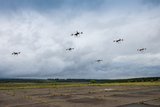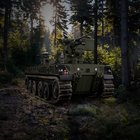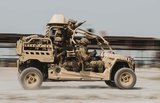Lockheed Martin flies first 360-degree infrared sensor on small unmanned aircraft system
Lockheed Martin recently completed a successful test of a new infrared sensor turret aboard its Desert Hawk III Unmanned Aircraft System (UAS), marking the first time a small UAS has flown with a 360-degree infrared sensor.
Battle-proven, the hand-launched Desert Hawk III has provided the British Army with critical Intelligence, Surveillance and Reconnaissance (ISR) capabilities in both Iraq and Afghanistan. The small UAS (54-inch wingspan) is specifically designed to operate at high altitudes, in high winds and extreme temperatures.
Successful flight tests of the Desert Hawk III’s new payload offering, held September 23- 24 at the Minnesota National Guard’s Camp Ripley unmanned vehicle proving grounds, validate the UAS's ability to greatly improve nighttime ISR for ground forces. By providing 360-degree infrared coverage, troops obtain greater target location accuracy and superior image stability. Combined with an upgraded 360-degree color Electro Optic (E/O) sensor, operators gained 10 times continuous zoom capability, significantly aiding in contact identification.
“To assist the warfighter, we have miniaturized the infrared payload, so it fits into a turret weighing less than two pounds," said John Nikolai, director of electronic products & logistics at Lockheed Martin’s Tactical Systems business in Eagan, MN. "The E/O camera has been upgraded as well, for improved target identification. With the introduction of these sensor capabilities, users will experience vastly improved nighttime situational awareness.”
Lockheed Martin’s Desert Hawk III features an open architecture environment and consists of a lightweight, hand-launched, ruggedized air vehicle with snap-on Plug and PlayloadsTM, a portable ground station and a remote video terminal. The snap-on payload capability allows a single operator to swap sensors on the air vehicle in less than one minute to meet immediate and rapidly changing mission requirements.
Currently, the Desert Hawk III offers five modular capability payloads for mission flexibility. The payloads include a 360-degree turret with a mix of E/O and/or black and white low-light imagers, an infrared stabilized imager in a roll axis out to 90 degrees, a signals intelligence sensor, the new 360-degree infrared sensor and the upgraded 360-degree E/O imager with continuous zoom.
More from Uncrewed Vehicles
-
![Ready for the race: Air separation drone swarms vs. air defence systems]()
Ready for the race: Air separation drone swarms vs. air defence systems
As the dynamics of aerial combat rapidly evolve, Chinese scientists have engineered a sophisticated air separation drone model that can fragment into up to six drones, each capable of executing distinct battlefield roles and challenging the efficacy of current anti-drone defences such as the UK’s Dragonfire laser system.
-
![Israel’s MALE UAVs ‘must adapt’ to Iranian-made air defences]()
Israel’s MALE UAVs ‘must adapt’ to Iranian-made air defences
Advancements in air defence technologies have begun to reshape aerial combat dynamics in the Middle East, as illustrated by recent events involving the Israeli Air Force and Hezbollah.
-
![Hundreds more UAS sent to Ukraine forces with thousands more on the way]()
Hundreds more UAS sent to Ukraine forces with thousands more on the way
Both sides of the Russia-Ukraine war have been using UAS for effective low-cost attacks, as well as impactful web and social media footage. Thousands more have now been committed to Ukrainian forces.
-
![AI and software companies selected for US Army Robotic Combat Vehicle subsystems]()
AI and software companies selected for US Army Robotic Combat Vehicle subsystems
The US Army has intentions to develop light, medium and heavy variants of the Robotic Combat Vehicle (RCV) as part of the branche’s Next Generation Combat Vehicle family.
-
![DroneShield to improve software of DroneSentry-X C-UAS system under new contract]()
DroneShield to improve software of DroneSentry-X C-UAS system under new contract
DroneSentry-X, a cross-vehicle compatible, automated 360° C-UAS detect and defeat device, can offer 360° awareness and protection using integrated sensors. According to its manufacturer, it is suitable for mobile operations, on-site surveillance and on-the-move missions.
-
![Ukraine takes delivery of new indigenous C-UAS systems]()
Ukraine takes delivery of new indigenous C-UAS systems
Funded by the country’s former president, the new C-UAS systems will be sent to the frontline where they have already been tested against Russian invading forces.


























